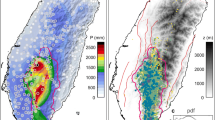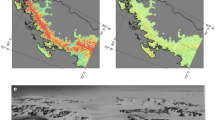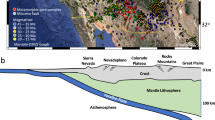Abstract
Surface movements during the largest subduction zone earthquakes commonly drown coastlines. Yet, on geological timescales, coastlines above subduction zones uplift. Here I use a morphometric analysis combined with a numerical model of landscape evolution to estimate uplift rates along the central Andean rasa—a low-relief coastal surface bounded by a steep cliff formed by wave erosion. I find that the rasa has experienced steady uplift of 0.13 ± 0.04 mm per year along a stretch of more than 2,000 km in length, during the Quaternary. These long-term uplift rates do not correlate with Global Positioning System (GPS) measurements of interseismic movements over the decadal scale, which implies that permanent uplift is not predominantly accumulated during the interseismic period. Instead, the rate of rasa uplift correlates with slip during earthquakes straddling the crust–mantle transition, the Moho. Such deeper earthquakes with magnitude 7 to 8 that occurred between 1995 and 2012 resulted in decimetres of coastal uplift. Slip during these earthquakes is located below the locked portion of the plate interface, and therefore may translate into permanent deformation of the overlying plate, where it causes uplift of the coastline. Thus, lower parts of the plate boundary are stably segmented over hundreds to millions of years. I suggest the coastline marks the surface expression of the transition between the shallow, locked seismogenic domain and the deeper, conditionally stable domain where modest earthquakes build up topography.
This is a preview of subscription content, access via your institution
Access options
Subscribe to this journal
Receive 12 print issues and online access
$259.00 per year
only $21.58 per issue
Buy this article
- Purchase on Springer Link
- Instant access to full article PDF
Prices may be subject to local taxes which are calculated during checkout





Similar content being viewed by others
References
Darwin, C., Sowerby, G. B. & Forbes, E. Geological Observations on South America (Smith, Elder and Co., 1846).
Atwater, B. F., Núñez, H. J. & Vita-Finzi, C. Net late Holocene emergence despite earthquake-induced submergence, south-central Chile. Quat. Int. 15, 77–85 (1992).
Briggs, R. W. et al. Persistent elastic behavior above a megathrust rupture patch: Nias island, West Sumatra. J. Geophys. Res. 113, B12406 (2008).
Jara-Muñoz, J., Melnick, D., Brill, D. & Strecker, M. R. Segmentation of the 2010 Maule Chile earthquake rupture from a joint analysis of uplifted marine terraces and seismic-cycle deformation patterns. Quat. Sci. Rev. 113, 171–192 (2015).
Peterson, C. D. & Cruikshank, K. M. Quaternary tectonic deformation, Holocene paleoseismicity, and modern strain in the unusually-wide coupled zone of the Central Cascadia Margin, Washington and Oregon, USA, and British Columbia, Canada. J. Geogr. Geol. 6, 1–33 (March, 2014).
Sawai, Y. et al. Transient uplift after a 17th-century earthquake along the Kuril subduction zone. Science 306, 1918–1920 (2004).
Matsu’Ura, T., Furusawa, A. & Saomoto, H. Long-term and short-term vertical velocity profiles across the forearc in the NE Japan subduction zone. Quat. Res. 71, 227–238 (2009).
Ozawa, S. et al. Preceding, coseismic, and postseismic slips of the 2011 Tohoku earthquake, Japan. J. Geophys. Res. 117, B07404 (2012).
Armijo, R. & Thiele, R. Active faulting in northern Chile: ramp stacking and lateral decoupling along a subduction plate boundary? Earth Planet. Sci. Lett. 98, 40–61 (1990).
Adam, J. & Reuther, C. D. Crustal dynamics and active fault mechanics during subduction erosion. Application of frictional wedge analysis on to the North Chilean Forearc. Tectonophysics 321, 297–325 (2000).
Clift, P. D. & Hartley, A. J. Slow rates of subduction erosion and coastal underplating along the Andean margin of Chile and Peru. Geology 35, 503–506 (2007).
Armijo, R., Lacassin, R., Coudurier-Curveur, A. & Carrizo, D. Coupled tectonic evolution of Andean orogeny and global climate. Earth Sci. Rev. 143, 1–35 (2015).
Allmendinger, R. W. & González, G. Invited review paper: neogene to quaternary tectonics of the coastal Cordillera, northern Chile. Tectonophysics 495, 93–110 (2010).
Baker, A., Allmendinger, R. W., Owen, L. A. & Rech, J. A. Permanent deformation caused by subduction earthquakes in northern Chile. Nature Geosci. 6, 492–496 (2013).
Béjar-Pizarro, M. et al. Andean structural control on interseismic coupling in the North Chile subduction zone. Nature Geosci. 6, 462–467 (2013).
Schurr, B. et al. The 2007 M7.7 Tocopilla northern Chile earthquake sequence: implications for along-strike and downdip rupture segmentation and megathrust frictional behavior. J. Geophys. Res. 117, B05305 (2012).
Oncken, O. et al. Seismic imaging of a convergent continental margin and plateau in the central Andes (Andean Continental Research Project 1996 (ANCORP’96)). J. Geophys. Res. Solid Earth 108, 2328 (2003).
von Huene, R. & Ranero, C. R. Subduction erosion and basal friction along the sediment-starved convergent margin off Antofagasta, Chile. J. Geophys. Res. Solid Earth 108, 2079 (2003).
Lamb, S. & Davis, P. Cenozoic climate change as a possible cause for the rise of the Andes. Nature 425, 792–797 (2003).
Martinod, J. et al. How do subduction processes contribute to forearc Andean uplift? Insights from numerical models. J. Geodyn. http://dx.doi.org/10.1016/j.jog.2015.04.001 (in the press, 2016).
Delouis, B., Philip, H., Dorbath, L. & Cisternas, A. Recent crustal deformation in the Antofagasta region (northern Chile) and the subduction process. Geophys. J. Int. 132, 302–338 (1998).
Ocola, L. Southern Peru coseismic subsidence: 23 June 2001 8.4-Mw earthquake. Adv. Geosci. 14, 79–83 (2008).
Schurr, B. et al. Gradual unlocking of plate boundary controlled initiation of the 2014 Iquique earthquake. Nature 512, 299–302 (2014).
Contreras-Reyes, E., Jara, J., Grevemeyer, I., Ruiz, S. & Carrizo, D. Abrupt change in the dip of the subducting plate beneath north Chile. Nature Geosci. 5, 342–345 (2012).
Paskoff, R. Quaternary of Chile: the state of research. Quat. Res. 8, 2–31 (1977).
Pedoja, K. et al. Coastal staircase sequences reflecting sea-level oscillations and tectonic uplift during the Quaternary and Neogene. Earth Sci. Rev. 132, 13–38 (2014).
Pedoja, K. et al. Relative sea-level fall since the last interglacial stage: are coasts uplifting worldwide? Earth Sci. Rev. 108, 1–15 (2011).
Regard, V. et al. Renewed uplift of the Central Andes Forearc revealed by coastal evolution during the Quaternary. Earth Planet. Sci. Lett. 297, 199–210 (2010).
Quezada, J., Gonzalez, G., Dunai, T., Jensen, A. & Juez-Larre, J. Pleistocene littoral uplift of northern Chile: Ne-21 age of the upper marine terrace of Caldera-Bahia Inglesa area. Rev. Geol. Chil. 34, 81–96 (2007).
Rodríguez, M. P. et al. Geochronology of pediments and marine terraces in north-central Chile and their implications for Quaternary uplift in the Western Andes. Geomorphology 180, 33–46 (2013).
García, M., Riquelme, R., Farías, M., Hérail, G. & Charrier, R. Late Miocene–Holocene canyon incision in the western Altiplano, northern Chile: tectonic or climatic forcing? J. Geol. Soc. 168, 1047–1060 (2011).
Malatesta, C., Gerya, T., Crispini, L., Federico, L. & Capponi, G. Oblique subduction modelling indicates along-trench tectonic transport of sediments. Nature Commun. 4, 2456 (2013).
Lay, T. et al. Depth-varying rupture properties of subduction zone megathrust faults. J. Geophys. Res. Solid Earth 117, B04311 (2012).
Farías, M. et al. Land-level changes produced by the Mw 8.8 2010 Chilean earthquake. Science 329, 916 (2010).
Delouis, B. et al. The Mw = 8.0 Antofagasta (northern Chile) earthquake of 30 July 1995: a precursor to the end of the large 1877 gap. Bull. Seismol. Soc. Am. 87, 427–445 (1997).
Béjar-Pizarro, M. et al. Asperities and barriers on the seismogenic zone in North Chile: state-of-the-art after the 2007 Mw 7.7 Tocopilla earthquake inferred by GPS and InSAR data. Geophys. J. Int. 183, 390–406 (2010).
Ruiz, S. et al. The Constitución earthquake of 25 March 2012: a large aftershock of the Maule earthquake near the bottom of the seismogenic zone. Earth Planet. Sci. Lett. 377, 347–357 (2013).
Peyrat, S. et al. Tarapacá intermediate-depth earthquake (Mw 7.7, 2005, northern Chile): a slab-pull event with horizontal fault plane constrained from seismologic and geodetic observations. Geophys. Res. Lett. 33, L22308 (2006).
Métois, M. et al. GPS-derived interseismic coupling on the subduction and seismic hazards in the Atacama region, Chile. Geophys. J. Int. 196, 644–655 (2014).
Li, S., Moreno, M., Bedford, J., Rosenau, M. & Oncken, O. Revisiting visco-elastic effects on interseismic deformation and locking degree: a case study of the Peru—North Chile subduction zone. J. Geophys. Res. Solid Earth 120, 4522–4538 (2015).
Comte, D. & Pardo, M. Reappraisal of great historical earthquakes in the northern Chile and southern Peru seismic gaps. Nat. Hazards 4, 23–44 (1991).
Wang, K., Hu, Y. & He, J. Deformation cycles of subduction earthquakes in a viscoelastic Earth. Nature 484, 327–332 (2012).
Wang, K. & Bilek, S. L. Invited review paper: fault creep caused by subduction of rough seafloor relief. Tectonophysics 610, 1–24 (2014).
Vergnolle, M. et al. Slow slip events in Mexico revised from the processing of 11 year GPS observations. J. Geophys. Res. Solid Earth 115, B08403 (2010).
Paul, J., Rajendran, C. P., Lowry, A. R., Andrade, V. & Rajendran, K. Andaman postseismic deformation observations: still slipping after all these years? Bull. Seismol. Soc. Am. 102, 343–351 (2012).
Hsu, Y.-J. et al. Frictional afterslip following the 2005 Nias-Simeulue earthquake, Sumatra. Science 312, 1921–1926 (2006).
Noda, H. & Lapusta, N. Stable creeping fault segments can become destructive as a result of dynamic weakening. Nature 493, 518–521 (2013).
Witter, R. C. et al. Unusually large tsunamis frequent a currently creeping part of the Aleutian megathrust. Geophys. Res. Lett. 43, 76–84 (2016).
Allen, T. I., Marano, K. D., Earle, P. S. & Wald, D. J. PAGER-CAT: a composite earthquake catalog for calibrating global fatality models. Seismol. Res. Lett. 80, 57–62 (2009).
Pritchard, M. E., Ji, C. & Simons, M. Distribution of slip from 11 Mw > 6 earthquakes in the northern Chile subduction zone. J. Geophys. Res. Solid Earth 111, B10302 (2006).
Jara-Muñoz, J., Melnick, D. & Strecker, M. R. TerraceM: a Matlab GUI to analize wave-cut terraces from high-resolution topography. Geosphere 12, 1–20 (2016).
Bintanja, R., van de Wal, R. S. W. & Oerlemans, J. Modelled atmospheric temperatures and global sea levels over the past million years. Nature 437, 125–128 (2005).
Schweller, W. J., Kulm, L. D. & Prince, R. A. Tectonics, structure, and sedimentary framework of the Peru–Chile trench. Geol. Soc. Am. Mem. 154, 323–349 (1981).
DeMets, C., Gordon, R. G. & Argus, D. F. Geologically current plate motions. Geophys. J. Int. 181, 1–80 (2010).
Hayes, G. P., Wald, D. J. & Johnson, R. L. Slab1.0: a three-dimensional model of global subduction zone geometries. J. Geophys. Res. Solid Earth 117, B01302 (2012).
Sunamura, T. Geomorphology of Rocky Coasts (John Wiley, 1992).
Anderson, R., Densmore, A. & Ellist, M. The generation and degredation of marine terraces. Basin Res. 11, 7–19 (1999).
Hanks, T. C. in Quaternary Geochronology: Methods and Applications Vol. 4 (eds Noller, J. S., Sowers, J. M. & Lettis, W. R.) 313–338 (American Geopysical Union, 2000).
Okada, Y. Surface deformation due to shear and tensile faults in a half-space. Bull. Seismol. Soc. Am. 75, 1135–1154 (1985).
Tassara, A. & Echaurren, A. Anatomy of the Andean subduction zone: three-dimensional density model upgraded and compared against global-scale models. Geophys. J. Int. 189, 161–168 (2012).
Motagh, M. et al. Subduction earthquake deformation associated with 14 November 2007, Mw 7.8 Tocopilla earthquake in Chile: results from InSAR and aftershocks. Tectonophysics 490, 60–68 (2010).
Acknowledgements
This study was supported by German Science Foundation (DFG) grant ME 3157/4-1. Reviews by R. Briggs and J. Martinod helped to improve the paper. I thank J. Jara-Muñoz and K. Pedoja for discussions on marine terraces, M. Moreno on the earthquake cycle, and the continuous support of M. Strecker.
Author information
Authors and Affiliations
Corresponding author
Ethics declarations
Competing interests
The author declares no competing financial interests.
Supplementary information
Supplementary Information
Supplementary Information (PDF 22027 kb)
Supplementary Information
Supplementary Information (MOV 1004 kb)
Supplementary Information
Supplementary Information (ZIP 47 kb)
Rights and permissions
About this article
Cite this article
Melnick, D. Rise of the central Andean coast by earthquakes straddling the Moho. Nature Geosci 9, 401–407 (2016). https://doi.org/10.1038/ngeo2683
Received:
Accepted:
Published:
Issue Date:
DOI: https://doi.org/10.1038/ngeo2683
This article is cited by
-
Imaging the subsurface architecture in porphyry copper deposits using local earthquake tomography
Scientific Reports (2023)
-
Contribution of background seismicity to forearc uplift
Nature Geoscience (2021)
-
Transient stripping of subducting slabs controls periodic forearc uplift
Nature Communications (2020)
-
Chilean megathrust earthquake recurrence linked to frictional contrast at depth
Nature Geoscience (2018)
-
Megathrusts and mountain building
Nature Geoscience (2016)



